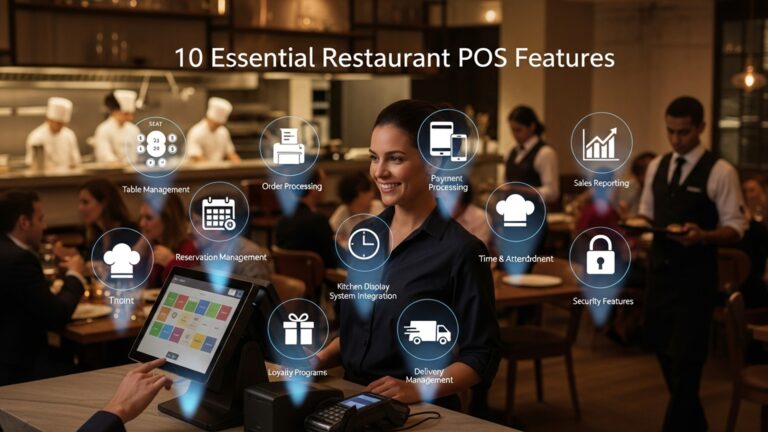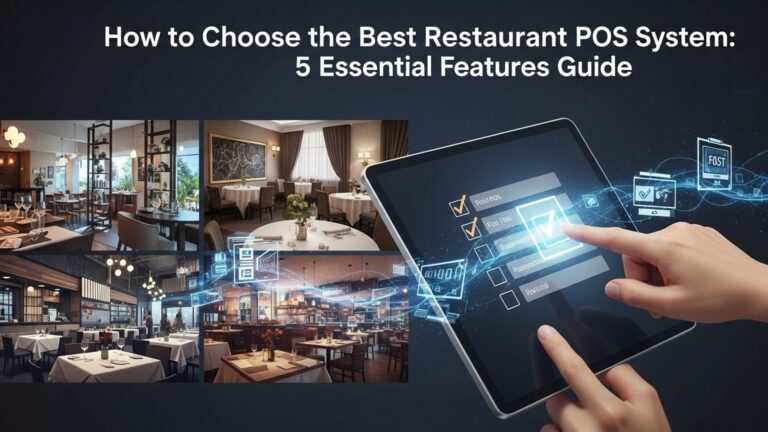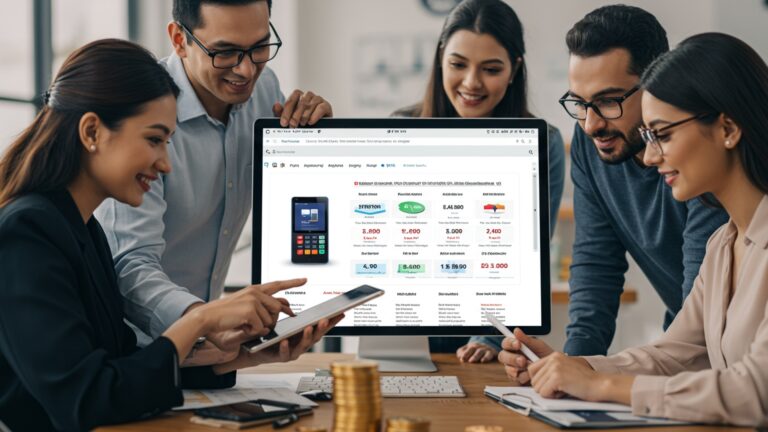How to Choose the Best Restaurant POS System Features for Your Business
Navigating the complex landscape of restaurant technology demands a strategic approach, especially when selecting the best restaurant POS system features. Modern establishments, from bustling bistros to quick-service cafes, recognize that their POS is far more than a simple transaction tool; it’s the operational heartbeat dictating efficiency and guest satisfaction. Today’s cutting-edge systems integrate crucial elements like real-time inventory management for precision stock control, advanced kitchen display systems (KDS) for streamlined order fulfillment. robust CRM tools powering loyalty programs and personalized guest experiences. With the rise of AI-driven analytics and seamless third-party delivery integrations, choosing the right features directly impacts profitability and staff efficiency, defining the very future of your dining concept in a competitive market.
Understanding the Core of a Restaurant POS System
In the bustling world of hospitality, a Point of Sale (POS) system is far more than just a cash register; it’s the central nervous system of a modern restaurant. At its heart, a restaurant POS system is a combination of hardware and software designed to streamline operations, manage sales. enhance the customer experience. Historically, POS systems were bulky, on-premise units primarily focused on transaction processing. Today, they’ve evolved into sophisticated, often cloud-based, platforms that integrate various aspects of a business, from order taking to inventory management and detailed analytics.
Key components typically include:
- Hardware: This usually involves a touchscreen terminal, a cash drawer, a receipt printer. a barcode scanner. Some setups also include kitchen display screens (KDS), customer-facing displays. handheld devices for tableside ordering.
- Software: The operational brains of the system. This handles everything from menu configuration, order processing, payment collection. reporting. Modern software is often modular, allowing businesses to activate specific features as needed.
- Payment Processing: Integration with payment gateways to accept various forms of payment, including credit cards, debit cards, mobile payments (e. g. , Apple Pay, Google Pay). contactless options.
- Network Connectivity: For cloud-based systems, a reliable internet connection is crucial for data synchronization, remote access. real-time updates. On-premise systems might rely more on local networks.
The goal is to move beyond simple transaction recording to a comprehensive management tool that provides insights, reduces errors. improves efficiency across all restaurant functions. Choosing the best restaurant POS system features involves understanding these fundamental elements and how they can be leveraged for your specific business model.
Essential Front-of-House (FOH) Features for Customer Experience
The front-of-house (FOH) features of a POS system are those directly interacting with customers and influencing their dining experience. These are crucial for efficient service, accurate order taking. swift transactions, making them vital considerations when evaluating the best restaurant POS system features.
- Order Management: This is the cornerstone. It allows staff to quickly take orders, customize items (e. g. , “no onions,” “extra cheese”), split checks. manage coursing. Advanced systems offer intuitive interfaces, often with visual menus, speeding up the ordering process and reducing errors. For example, a server can use a handheld device to take an order at the table, which immediately transmits to the kitchen, improving speed and accuracy.
- Table Management: Essential for sit-down restaurants, this feature provides a visual layout of your dining room, allowing staff to assign tables, track their status (e. g. , seated, ordering, eating, paid). manage reservations or waitlists. This helps optimize seating arrangements and server assignments, ensuring smooth service flow, especially during peak hours.
- Customer Relationship Management (CRM): A built-in CRM allows you to capture customer data such as order history, preferences. contact insights. This data can be used to personalize service, offer targeted promotions. build loyalty. For instance, knowing a customer’s favorite dish or dietary restrictions can enhance their experience on subsequent visits.
- Mobile Ordering & Payments: The ability for customers to order and pay directly from their smartphones (e. g. , via QR codes at the table) reduces server workload and empowers customers. Similarly, staff using handheld devices for tableside ordering and payment processing can significantly speed up service and table turnover.
- Online Ordering Integration: In today’s digital age, online ordering is non-negotiable. The best restaurant POS system features include seamless integration with your website or third-party delivery platforms. Orders placed online should flow directly into your POS and kitchen display system, eliminating manual entry and potential errors.
Critical Back-of-House (BOH) Features for Operational Efficiency
While FOH features focus on customer interaction, BOH features are the workhorses that keep your restaurant running smoothly behind the scenes. These features are critical for managing costs, optimizing resources. making informed business decisions, making them a significant part of the best restaurant POS system features evaluation.
- Inventory Management: This feature tracks ingredients and supplies in real-time, from receiving to consumption. It helps prevent waste, identifies popular items. automates reordering. For example, if a specific ingredient is running low based on sales data, the system can alert you or even automatically generate a purchase order. This minimizes spoilage and ensures you never run out of critical items.
- Employee Management & Time Tracking: This allows you to manage staff schedules, track clock-ins and clock-outs, calculate wages. monitor performance. Some systems even integrate with payroll providers. This ensures accurate labor cost reporting and compliance with labor laws. Imagine easily generating a report showing server performance based on sales or tips, which can inform training or incentive programs.
- Reporting & Analytics: Comprehensive reporting tools are invaluable. They provide insights into sales trends, peak hours, popular menu items, labor costs. more. Customizable reports allow managers to track key performance indicators (KPIs) and make data-driven decisions. For instance, identifying slow-moving menu items through sales reports can prompt menu adjustments or promotions.
// Example of a simple sales query concept for a POS system's analytics SELECT DATE(order_timestamp) AS sale_date, SUM(total_amount) AS daily_sales, COUNT(DISTINCT order_id) AS total_orders FROM sales_transactions WHERE order_timestamp BETWEEN '2023-01-01' AND '2023-01-31' GROUP BY sale_date ORDER BY sale_date; - Kitchen Display Systems (KDS) Integration: A KDS replaces paper tickets in the kitchen with digital screens. Orders from the POS are sent directly to the KDS, displaying items, modifications. cook times. This improves kitchen efficiency, reduces errors. helps manage order flow, especially during busy periods. Different screens can be assigned to different stations (e. g. , grill, prep, expediter).
- Recipe Management: For precise cost control and consistent quality, recipe management allows you to input exact ingredient quantities for each menu item. This links directly to inventory, deducting ingredients as dishes are sold and providing accurate food costing. This feature is crucial for maintaining profit margins and ensuring every dish tastes the same, regardless of who’s cooking.
Advanced and Specialized Features for Enhanced Operations
Beyond the essentials, certain advanced and specialized features can significantly enhance specific restaurant operations or cater to unique business models. When aiming for the best restaurant POS system features, consider how these additions can differentiate your establishment.
- Multi-Location Management: For restaurant groups or franchises, this feature allows centralized management of menus, pricing, inventory. reporting across multiple locations. It provides a holistic view of the entire business, enabling consistent branding and efficient scaling. A corporate chef, for example, could update a menu item’s recipe across all branches simultaneously from a single dashboard.
- Loyalty Programs: Integrated loyalty programs allow you to reward repeat customers with points, discounts, or exclusive offers. This encourages customer retention and increases average spend. Systems often automate point accumulation and redemption, making it seamless for both customers and staff.
- Reservations Management: For fine dining or busy establishments, an integrated reservation system allows customers to book tables online or via phone. managers to track availability, seating preferences. guest history. This reduces no-shows and optimizes table turnover.
- Delivery Management & Third-Party Integrations: As delivery services proliferate, integrating your POS with platforms like DoorDash, Uber Eats, or Grubhub streamlines operations. Orders from these platforms flow directly into your POS, preventing manual re-entry and reducing errors. Some systems even offer integrated delivery driver management.
- Gift Card Management: The ability to sell, redeem. track gift cards directly through your POS system provides an additional revenue stream and acts as a powerful marketing tool. It simplifies accounting and ensures a smooth experience for customers using gift cards.
Technical Considerations and Integrations
Understanding the technical underpinnings of a POS system is crucial for long-term reliability, scalability. seamless operation. These considerations play a significant role in determining the best restaurant POS system features for your specific environment.
- Cloud-Based vs. On-Premise:
This is a fundamental choice with significant implications:
Feature Cloud-Based POS On-Premise POS Data Storage Servers maintained by the vendor, accessible via internet. Local servers within the restaurant. Access Anywhere with internet access (laptop, tablet, phone). Primarily on-site, limited remote access unless configured. Cost Structure Subscription fees (monthly/annually), lower upfront cost. High upfront cost for hardware and software licenses, lower ongoing fees. Updates & Maintenance Automatic, managed by vendor. Manual updates, often requiring IT staff or vendor visits. Scalability Easily scalable, add/remove terminals as needed. Requires significant hardware upgrades to scale. Offline Mode Often includes an offline mode to continue operations during internet outages, syncing when reconnected. Generally more resilient to internet outages as data is local. Cloud-based systems offer flexibility and lower initial investment, making them popular for many modern restaurants. An on-premise system might appeal to those with specific security concerns or limited internet access, though these are becoming less common.
- Hardware Compatibility: Ensure the POS software is compatible with your chosen hardware, or consider an integrated solution where hardware and software are provided by the same vendor. This prevents compatibility issues and simplifies troubleshooting. Check for support for standard peripherals like thermal printers, cash drawers. barcode scanners.
- API Integrations (Accounting, Marketing, etc.) : The ability of your POS to connect with other business tools is paramount. Look for robust Application Programming Interface (API) integrations with accounting software (e. g. , QuickBooks, Xero), marketing platforms (e. g. , email marketing, social media). payroll services. This automates data flow, reduces manual entry. provides a more holistic view of your business. For example, daily sales data can automatically sync to your accounting software, saving hours of manual reconciliation.
- Security Features: Payment Card Industry Data Security Standard (PCI DSS) compliance is non-negotiable for any system handling credit card data. Look for features like end-to-end encryption, tokenization of payment data. user access controls to protect sensitive insights from breaches. Regular security audits and updates from the vendor are also crucial.
Choosing the Best Restaurant POS System Features: A Strategic Approach
Selecting the ideal POS system is a strategic decision that impacts every facet of your restaurant. It’s not just about finding a system with the most features. rather the right features that align with your specific operational needs and future goals. Here’s a structured approach to guide your decision-making process for the best restaurant POS system features.
- Assess Your Restaurant’s Unique Needs:
Start by outlining your current operations and pain points. Are you a quick-service cafe, a fine-dining establishment, a bar, or a food truck? Each model has different requirements. For example:
- A quick-service restaurant (QSR) might prioritize speed, mobile ordering. efficient drive-thru management.
- A fine-dining restaurant would focus on table management, reservations. detailed customer profiles.
- A bar would need robust tab management, happy hour pricing. advanced inventory for spirits.
Consider your menu complexity, average transaction volume. service style. In a real-world scenario, “The Daily Grind,” a small coffee shop, initially struggled with long queues. They opted for a POS system emphasizing quick order entry, integrated loyalty. a customer-facing display for order confirmation, significantly reducing wait times and improving customer satisfaction.
- Scalability:
Think about your future plans. Do you intend to expand, add more locations, or introduce new services like catering or delivery? The best restaurant POS system features should be scalable, meaning the system can grow with your business without requiring a complete overhaul. A cloud-based system often offers superior scalability compared to on-premise solutions.
- User-Friendliness & Training:
An intuitive interface is paramount. Your staff, regardless of their tech proficiency, should be able to quickly learn and efficiently use the system. A complex system, no matter how feature-rich, will lead to errors, slow service. frustrated employees. Inquire about the vendor’s training resources, documentation. the ease of onboarding new staff. A good vendor will offer comprehensive training materials and support.
- Vendor Support:
Even the most robust systems encounter issues. Reliable 24/7 customer support is critical, especially in the fast-paced restaurant environment. What kind of support does the vendor offer (phone, email, chat, in-person)? What are their response times? Read reviews and testimonials regarding their support quality. A former restaurant owner once told me, “A great POS with terrible support is worse than a mediocre POS with fantastic support. When the system goes down on a Saturday night, you need immediate help.”
- Cost Analysis (Upfront, Subscription, Hardware):
grasp the total cost of ownership. This includes:
- Upfront Costs: Hardware (terminals, printers, KDS, handhelds) and initial software setup fees.
- Subscription Fees: Monthly or annual software licensing fees (common for cloud-based systems).
- Payment Processing Fees: These can vary significantly between providers and often represent a hidden cost if not carefully reviewed.
- Maintenance & Support: Ongoing costs for software updates and technical assistance.
Always request a detailed quote that breaks down all potential costs. Compare different providers not just on price. on the value and features they offer for that price.
Conclusion
Choosing the best restaurant POS features isn’t merely about ticking boxes; it’s about strategically envisioning your restaurant’s future efficiency. My personal tip? Don’t get swayed by every shiny new integration; instead, focus on what genuinely streamlines your busiest Friday night service. Consider how features like robust table management or integrated online ordering, which is a major trend post-pandemic, will truly empower your servers and reduce bottlenecks. I’ve personally seen how a well-chosen system, like one that seamlessly integrates with popular delivery platforms such as DoorDash, can transform a struggling takeout operation into a local favorite, all while providing invaluable data insights into peak hours and popular dishes. This isn’t just about transactions; it’s about creating a smooth, profitable operational hub. Invest wisely. you’ll not only delight your customers but also empower your team to focus on what they do best: hospitality. Your perfect POS is out there, ready to elevate your business. Reference: [Restaurant Technology News & Insights](https://www. restaurantbusinessonline. com/technology)
More Articles
How to Optimize Your Restaurant’s Inventory Management
The Ultimate Guide to Contactless Payments in Restaurants
Leveraging POS Data for Restaurant Growth
Top 5 POS Systems for Small Cafes
Training Your Staff on New POS Technology
FAQs
What’s the absolute bare minimum a restaurant POS system must do for me?
Think about the essentials: taking orders accurately (including modifiers and special requests), processing payments reliably. giving you basic sales reports. For sit-down places, table management is also key. These are the core functions that keep your doors open and customers happy.
I run a busy café/quick-service place. What specific POS features should I really care about?
Speed is king for you! Look for super-fast order entry, quick modifier options (like ‘extra shot’ or ‘no onion’), easy split payments. robust kitchen display system (KDS) integration to keep the line moving. Mobile ordering integration is also a huge plus for convenience.
How vital is it for my POS to talk to my other business tools, like online ordering or accounting?
Super crucial! Seamless integration saves you tons of time and reduces errors. A POS that links up with your online ordering platforms, delivery services, inventory management software. accounting systems (like QuickBooks) means less manual data entry and a clearer overall picture of your business.
What kind of reporting and analytics features will actually help me interpret my restaurant better?
Beyond just daily sales, look for detailed insights. You’ll want reports on your best-selling items, peak service times, server performance, average check size. even ingredient usage. These features help you make smarter decisions about staffing, menu engineering. promotions.
Are there any features that can help me build customer loyalty and run marketing campaigns?
Absolutely! Look for built-in CRM (customer relationship management) tools, loyalty programs (points, rewards), gift card management. the ability to capture customer contact info for email marketing. These help you engage with your regulars and attract new ones.
Should I prioritize a POS system with strong inventory management features?
Definitely consider it! An integrated inventory system helps you track ingredients from delivery to plate, monitor food costs, minimize waste. even alert you when supplies are running low. It’s crucial for controlling expenses and managing your supply chain efficiently.
How can I pick a POS system that my staff will actually find easy to use?
A user-friendly interface is vital for staff satisfaction and efficiency. Look for intuitive touchscreen navigation, quick access to common functions (like splitting checks or applying discounts). clear order modification options. Good training resources and responsive support also play a big role in adoption.




